BUS502: International Marketing Plan for Australian Superfood Company
VerifiedAdded on 2023/04/03
|12
|3017
|260
Report
AI Summary
This report provides a comprehensive analysis of the international marketing strategy for the Australian Superfood Company, focusing on its potential entry into the Thailand market. The report begins with an introduction outlining the objectives, which include analyzing segmentation, targeting, positioning, and differentiation (STP&D) strategies, and then discusses the marketing mix strategies (product, price, place, and promotion). The segmentation analysis covers demographic, psychographic, geographic, and behavioral factors to identify the target consumer base in Thailand. The targeting strategy focuses on specific age groups, income levels, and lifestyle preferences. The positioning strategy aims to establish the company as a provider of premium quality organic products. The differentiation strategy highlights the innovative and unique aspects of the company's product offerings. The report further details the marketing mix strategies, including product innovation, pricing strategies, distribution channels, and promotional activities. The report concludes with a summary of the key findings and recommendations for the company to successfully enter and thrive in the Thailand market.
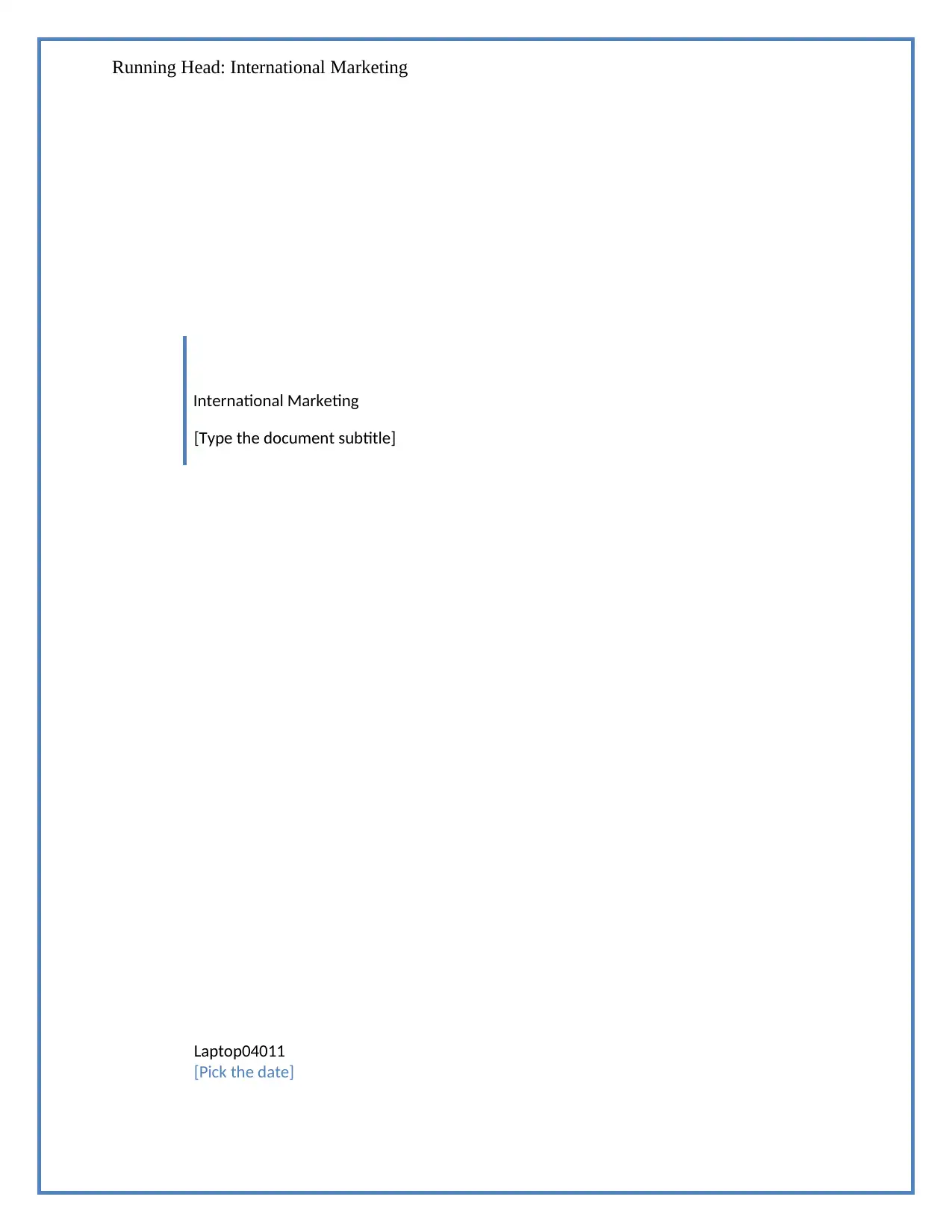
Running Head: International Marketing
International Marketing
[Type the document subtitle]
Laptop04011
[Pick the date]
International Marketing
[Type the document subtitle]
Laptop04011
[Pick the date]
Paraphrase This Document
Need a fresh take? Get an instant paraphrase of this document with our AI Paraphraser
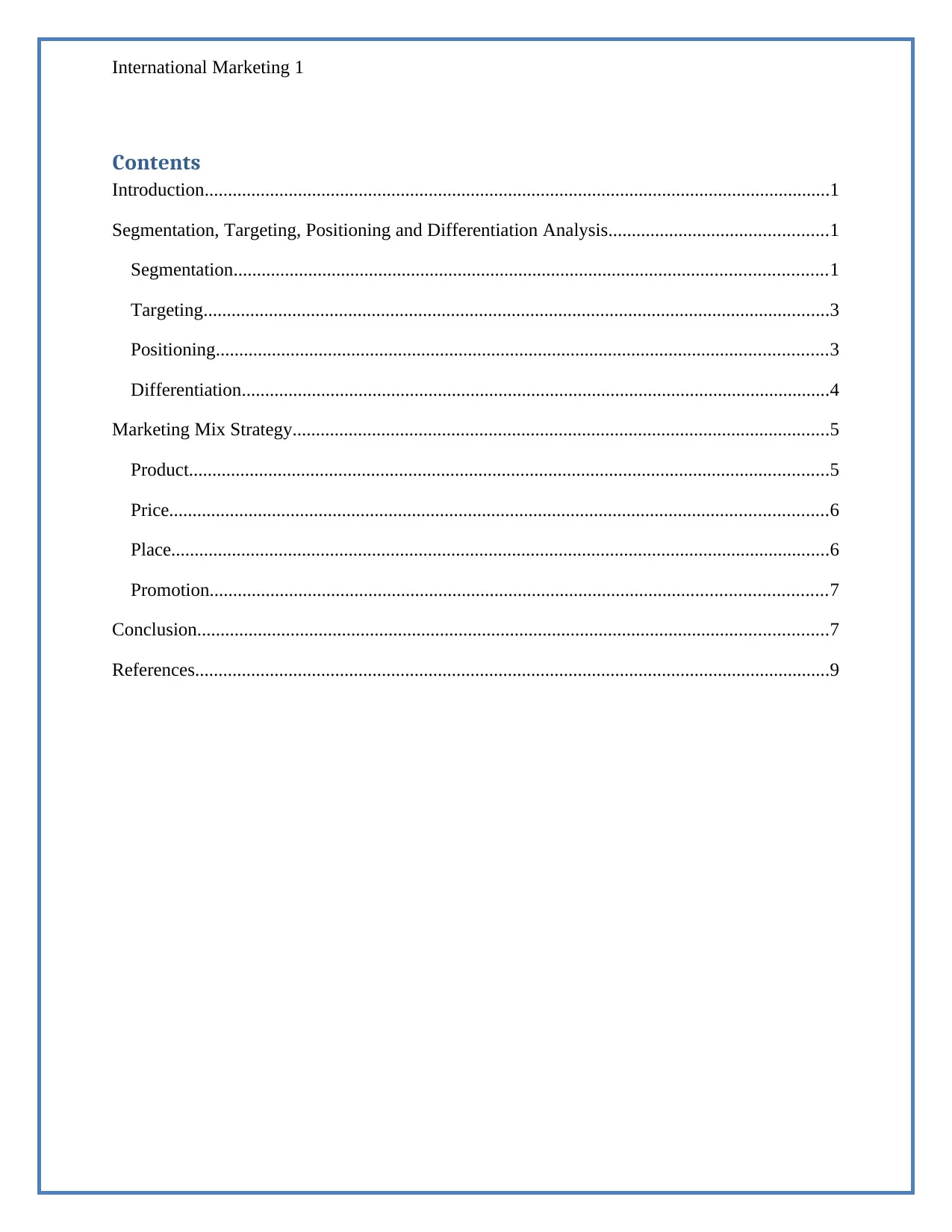
International Marketing 1
Contents
Introduction......................................................................................................................................1
Segmentation, Targeting, Positioning and Differentiation Analysis...............................................1
Segmentation...............................................................................................................................1
Targeting......................................................................................................................................3
Positioning...................................................................................................................................3
Differentiation..............................................................................................................................4
Marketing Mix Strategy...................................................................................................................5
Product.........................................................................................................................................5
Price.............................................................................................................................................6
Place.............................................................................................................................................6
Promotion....................................................................................................................................7
Conclusion.......................................................................................................................................7
References........................................................................................................................................9
Contents
Introduction......................................................................................................................................1
Segmentation, Targeting, Positioning and Differentiation Analysis...............................................1
Segmentation...............................................................................................................................1
Targeting......................................................................................................................................3
Positioning...................................................................................................................................3
Differentiation..............................................................................................................................4
Marketing Mix Strategy...................................................................................................................5
Product.........................................................................................................................................5
Price.............................................................................................................................................6
Place.............................................................................................................................................6
Promotion....................................................................................................................................7
Conclusion.......................................................................................................................................7
References........................................................................................................................................9
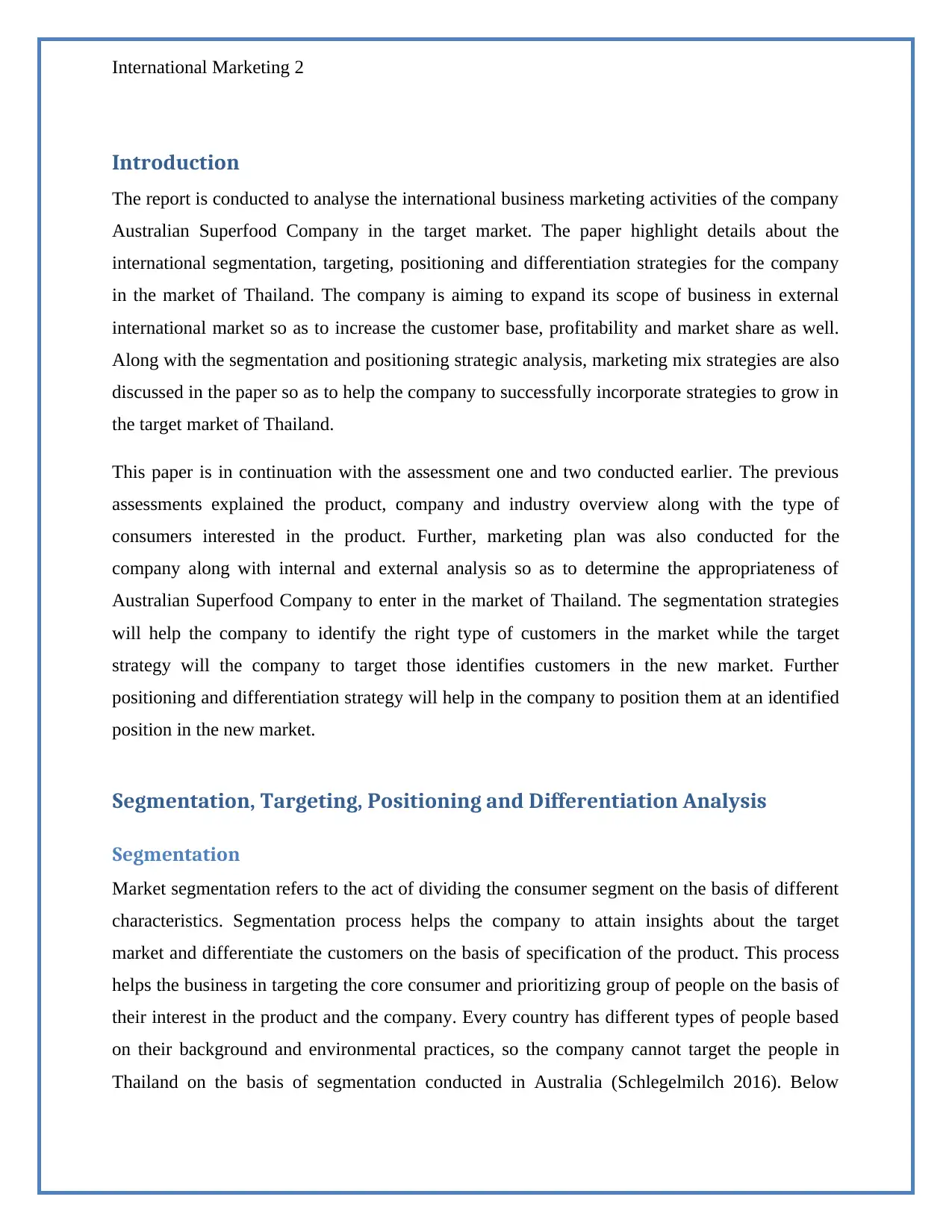
International Marketing 2
Introduction
The report is conducted to analyse the international business marketing activities of the company
Australian Superfood Company in the target market. The paper highlight details about the
international segmentation, targeting, positioning and differentiation strategies for the company
in the market of Thailand. The company is aiming to expand its scope of business in external
international market so as to increase the customer base, profitability and market share as well.
Along with the segmentation and positioning strategic analysis, marketing mix strategies are also
discussed in the paper so as to help the company to successfully incorporate strategies to grow in
the target market of Thailand.
This paper is in continuation with the assessment one and two conducted earlier. The previous
assessments explained the product, company and industry overview along with the type of
consumers interested in the product. Further, marketing plan was also conducted for the
company along with internal and external analysis so as to determine the appropriateness of
Australian Superfood Company to enter in the market of Thailand. The segmentation strategies
will help the company to identify the right type of customers in the market while the target
strategy will the company to target those identifies customers in the new market. Further
positioning and differentiation strategy will help in the company to position them at an identified
position in the new market.
Segmentation, Targeting, Positioning and Differentiation Analysis
Segmentation
Market segmentation refers to the act of dividing the consumer segment on the basis of different
characteristics. Segmentation process helps the company to attain insights about the target
market and differentiate the customers on the basis of specification of the product. This process
helps the business in targeting the core consumer and prioritizing group of people on the basis of
their interest in the product and the company. Every country has different types of people based
on their background and environmental practices, so the company cannot target the people in
Thailand on the basis of segmentation conducted in Australia (Schlegelmilch 2016). Below
Introduction
The report is conducted to analyse the international business marketing activities of the company
Australian Superfood Company in the target market. The paper highlight details about the
international segmentation, targeting, positioning and differentiation strategies for the company
in the market of Thailand. The company is aiming to expand its scope of business in external
international market so as to increase the customer base, profitability and market share as well.
Along with the segmentation and positioning strategic analysis, marketing mix strategies are also
discussed in the paper so as to help the company to successfully incorporate strategies to grow in
the target market of Thailand.
This paper is in continuation with the assessment one and two conducted earlier. The previous
assessments explained the product, company and industry overview along with the type of
consumers interested in the product. Further, marketing plan was also conducted for the
company along with internal and external analysis so as to determine the appropriateness of
Australian Superfood Company to enter in the market of Thailand. The segmentation strategies
will help the company to identify the right type of customers in the market while the target
strategy will the company to target those identifies customers in the new market. Further
positioning and differentiation strategy will help in the company to position them at an identified
position in the new market.
Segmentation, Targeting, Positioning and Differentiation Analysis
Segmentation
Market segmentation refers to the act of dividing the consumer segment on the basis of different
characteristics. Segmentation process helps the company to attain insights about the target
market and differentiate the customers on the basis of specification of the product. This process
helps the business in targeting the core consumer and prioritizing group of people on the basis of
their interest in the product and the company. Every country has different types of people based
on their background and environmental practices, so the company cannot target the people in
Thailand on the basis of segmentation conducted in Australia (Schlegelmilch 2016). Below
⊘ This is a preview!⊘
Do you want full access?
Subscribe today to unlock all pages.

Trusted by 1+ million students worldwide
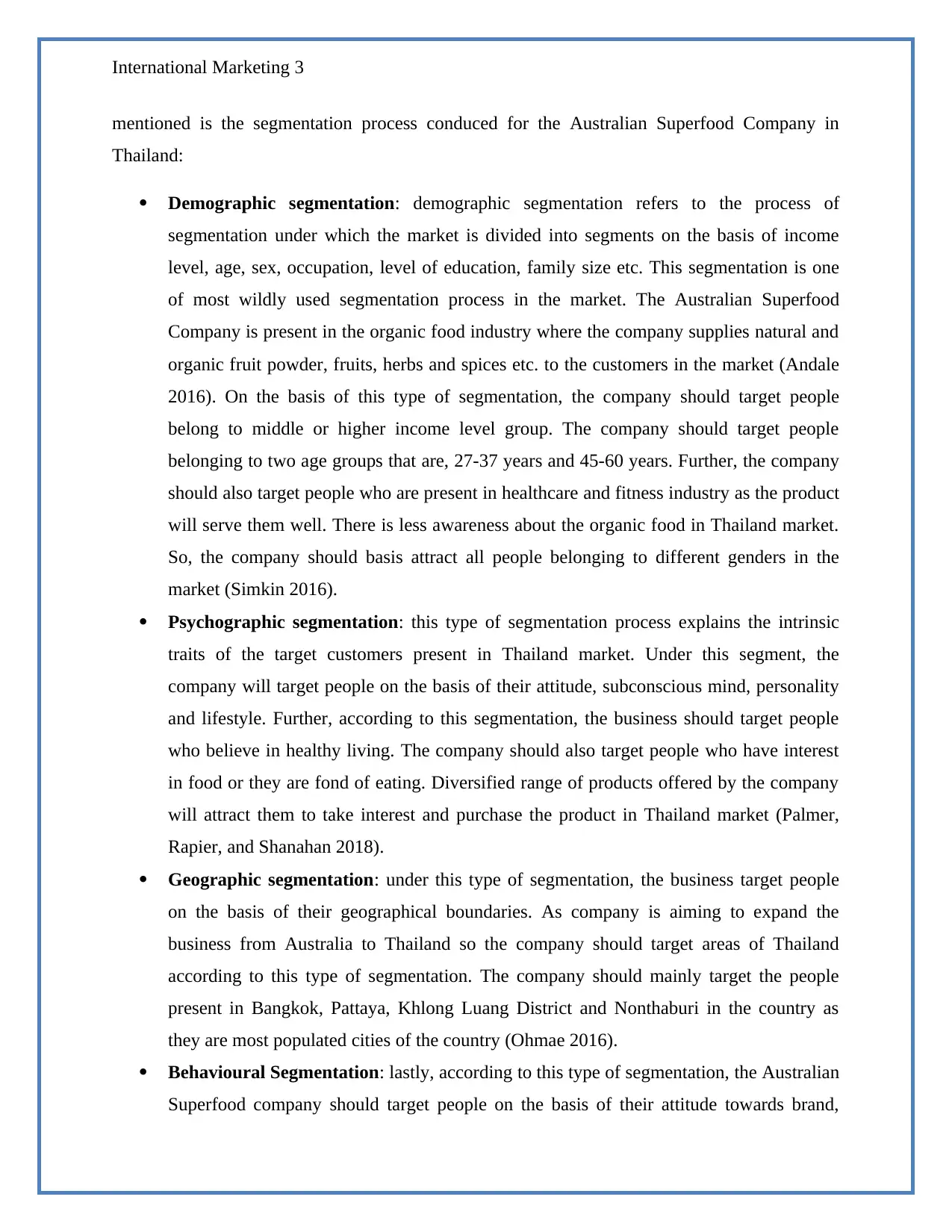
International Marketing 3
mentioned is the segmentation process conduced for the Australian Superfood Company in
Thailand:
Demographic segmentation: demographic segmentation refers to the process of
segmentation under which the market is divided into segments on the basis of income
level, age, sex, occupation, level of education, family size etc. This segmentation is one
of most wildly used segmentation process in the market. The Australian Superfood
Company is present in the organic food industry where the company supplies natural and
organic fruit powder, fruits, herbs and spices etc. to the customers in the market (Andale
2016). On the basis of this type of segmentation, the company should target people
belong to middle or higher income level group. The company should target people
belonging to two age groups that are, 27-37 years and 45-60 years. Further, the company
should also target people who are present in healthcare and fitness industry as the product
will serve them well. There is less awareness about the organic food in Thailand market.
So, the company should basis attract all people belonging to different genders in the
market (Simkin 2016).
Psychographic segmentation: this type of segmentation process explains the intrinsic
traits of the target customers present in Thailand market. Under this segment, the
company will target people on the basis of their attitude, subconscious mind, personality
and lifestyle. Further, according to this segmentation, the business should target people
who believe in healthy living. The company should also target people who have interest
in food or they are fond of eating. Diversified range of products offered by the company
will attract them to take interest and purchase the product in Thailand market (Palmer,
Rapier, and Shanahan 2018).
Geographic segmentation: under this type of segmentation, the business target people
on the basis of their geographical boundaries. As company is aiming to expand the
business from Australia to Thailand so the company should target areas of Thailand
according to this type of segmentation. The company should mainly target the people
present in Bangkok, Pattaya, Khlong Luang District and Nonthaburi in the country as
they are most populated cities of the country (Ohmae 2016).
Behavioural Segmentation: lastly, according to this type of segmentation, the Australian
Superfood company should target people on the basis of their attitude towards brand,
mentioned is the segmentation process conduced for the Australian Superfood Company in
Thailand:
Demographic segmentation: demographic segmentation refers to the process of
segmentation under which the market is divided into segments on the basis of income
level, age, sex, occupation, level of education, family size etc. This segmentation is one
of most wildly used segmentation process in the market. The Australian Superfood
Company is present in the organic food industry where the company supplies natural and
organic fruit powder, fruits, herbs and spices etc. to the customers in the market (Andale
2016). On the basis of this type of segmentation, the company should target people
belong to middle or higher income level group. The company should target people
belonging to two age groups that are, 27-37 years and 45-60 years. Further, the company
should also target people who are present in healthcare and fitness industry as the product
will serve them well. There is less awareness about the organic food in Thailand market.
So, the company should basis attract all people belonging to different genders in the
market (Simkin 2016).
Psychographic segmentation: this type of segmentation process explains the intrinsic
traits of the target customers present in Thailand market. Under this segment, the
company will target people on the basis of their attitude, subconscious mind, personality
and lifestyle. Further, according to this segmentation, the business should target people
who believe in healthy living. The company should also target people who have interest
in food or they are fond of eating. Diversified range of products offered by the company
will attract them to take interest and purchase the product in Thailand market (Palmer,
Rapier, and Shanahan 2018).
Geographic segmentation: under this type of segmentation, the business target people
on the basis of their geographical boundaries. As company is aiming to expand the
business from Australia to Thailand so the company should target areas of Thailand
according to this type of segmentation. The company should mainly target the people
present in Bangkok, Pattaya, Khlong Luang District and Nonthaburi in the country as
they are most populated cities of the country (Ohmae 2016).
Behavioural Segmentation: lastly, according to this type of segmentation, the Australian
Superfood company should target people on the basis of their attitude towards brand,
Paraphrase This Document
Need a fresh take? Get an instant paraphrase of this document with our AI Paraphraser
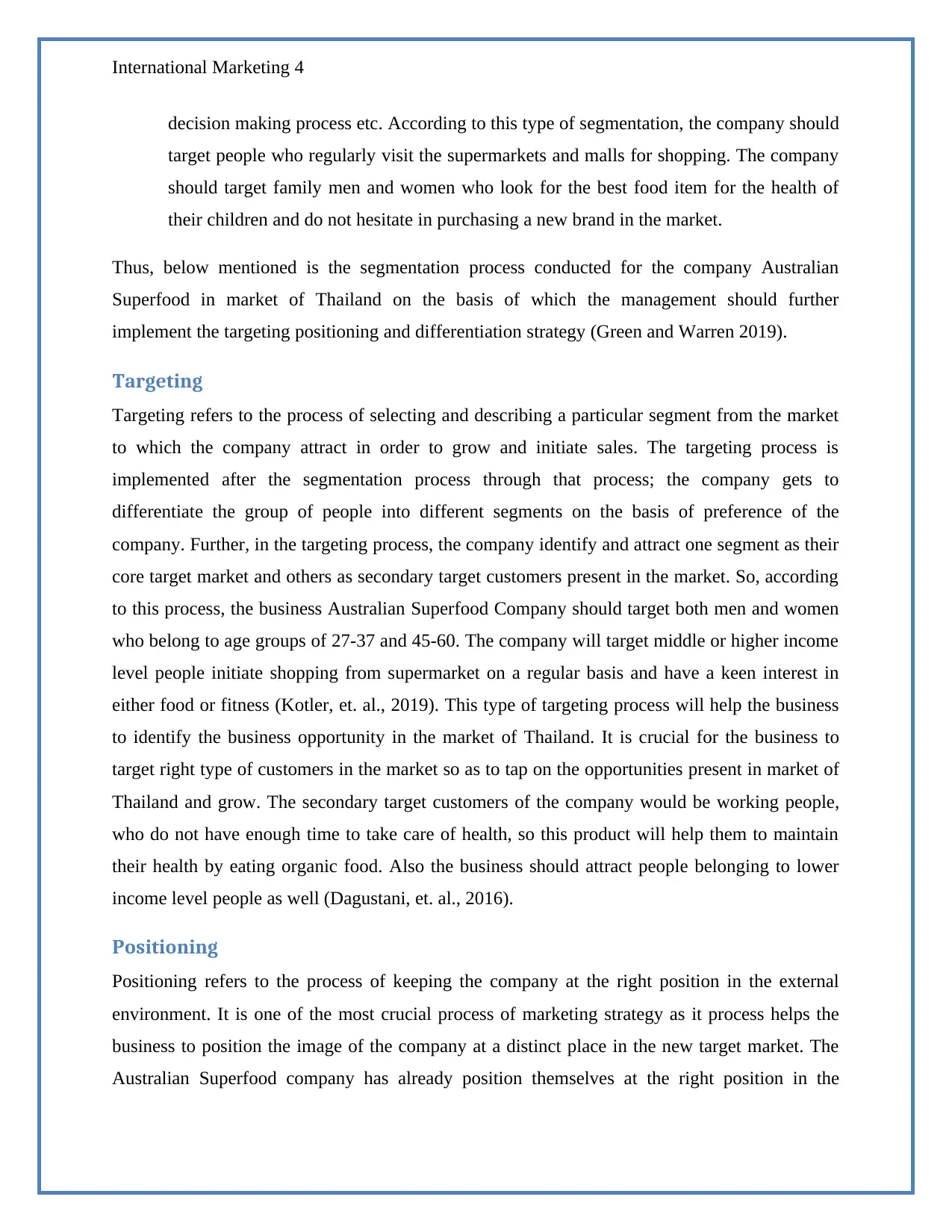
International Marketing 4
decision making process etc. According to this type of segmentation, the company should
target people who regularly visit the supermarkets and malls for shopping. The company
should target family men and women who look for the best food item for the health of
their children and do not hesitate in purchasing a new brand in the market.
Thus, below mentioned is the segmentation process conducted for the company Australian
Superfood in market of Thailand on the basis of which the management should further
implement the targeting positioning and differentiation strategy (Green and Warren 2019).
Targeting
Targeting refers to the process of selecting and describing a particular segment from the market
to which the company attract in order to grow and initiate sales. The targeting process is
implemented after the segmentation process through that process; the company gets to
differentiate the group of people into different segments on the basis of preference of the
company. Further, in the targeting process, the company identify and attract one segment as their
core target market and others as secondary target customers present in the market. So, according
to this process, the business Australian Superfood Company should target both men and women
who belong to age groups of 27-37 and 45-60. The company will target middle or higher income
level people initiate shopping from supermarket on a regular basis and have a keen interest in
either food or fitness (Kotler, et. al., 2019). This type of targeting process will help the business
to identify the business opportunity in the market of Thailand. It is crucial for the business to
target right type of customers in the market so as to tap on the opportunities present in market of
Thailand and grow. The secondary target customers of the company would be working people,
who do not have enough time to take care of health, so this product will help them to maintain
their health by eating organic food. Also the business should attract people belonging to lower
income level people as well (Dagustani, et. al., 2016).
Positioning
Positioning refers to the process of keeping the company at the right position in the external
environment. It is one of the most crucial process of marketing strategy as it process helps the
business to position the image of the company at a distinct place in the new target market. The
Australian Superfood company has already position themselves at the right position in the
decision making process etc. According to this type of segmentation, the company should
target people who regularly visit the supermarkets and malls for shopping. The company
should target family men and women who look for the best food item for the health of
their children and do not hesitate in purchasing a new brand in the market.
Thus, below mentioned is the segmentation process conducted for the company Australian
Superfood in market of Thailand on the basis of which the management should further
implement the targeting positioning and differentiation strategy (Green and Warren 2019).
Targeting
Targeting refers to the process of selecting and describing a particular segment from the market
to which the company attract in order to grow and initiate sales. The targeting process is
implemented after the segmentation process through that process; the company gets to
differentiate the group of people into different segments on the basis of preference of the
company. Further, in the targeting process, the company identify and attract one segment as their
core target market and others as secondary target customers present in the market. So, according
to this process, the business Australian Superfood Company should target both men and women
who belong to age groups of 27-37 and 45-60. The company will target middle or higher income
level people initiate shopping from supermarket on a regular basis and have a keen interest in
either food or fitness (Kotler, et. al., 2019). This type of targeting process will help the business
to identify the business opportunity in the market of Thailand. It is crucial for the business to
target right type of customers in the market so as to tap on the opportunities present in market of
Thailand and grow. The secondary target customers of the company would be working people,
who do not have enough time to take care of health, so this product will help them to maintain
their health by eating organic food. Also the business should attract people belonging to lower
income level people as well (Dagustani, et. al., 2016).
Positioning
Positioning refers to the process of keeping the company at the right position in the external
environment. It is one of the most crucial process of marketing strategy as it process helps the
business to position the image of the company at a distinct place in the new target market. The
Australian Superfood company has already position themselves at the right position in the
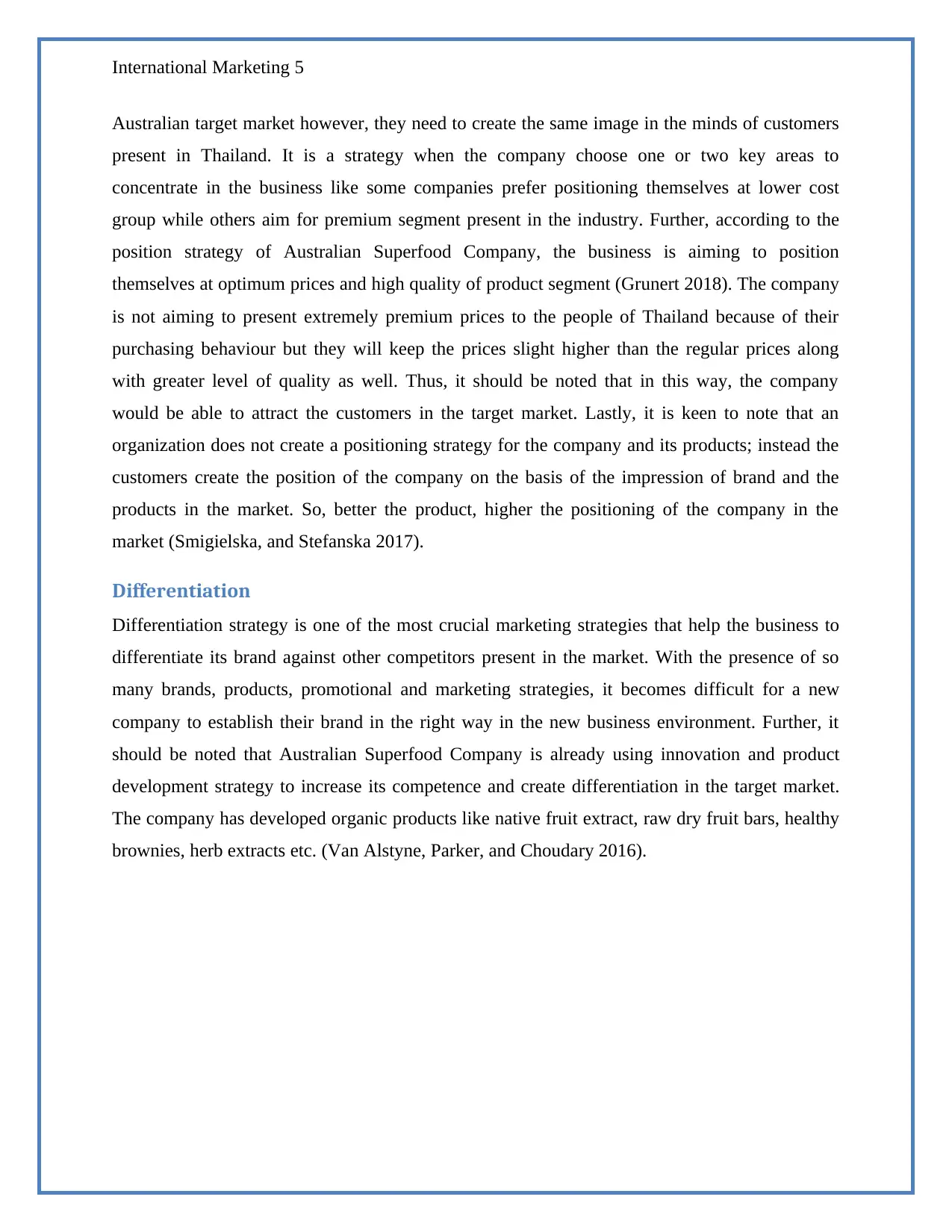
International Marketing 5
Australian target market however, they need to create the same image in the minds of customers
present in Thailand. It is a strategy when the company choose one or two key areas to
concentrate in the business like some companies prefer positioning themselves at lower cost
group while others aim for premium segment present in the industry. Further, according to the
position strategy of Australian Superfood Company, the business is aiming to position
themselves at optimum prices and high quality of product segment (Grunert 2018). The company
is not aiming to present extremely premium prices to the people of Thailand because of their
purchasing behaviour but they will keep the prices slight higher than the regular prices along
with greater level of quality as well. Thus, it should be noted that in this way, the company
would be able to attract the customers in the target market. Lastly, it is keen to note that an
organization does not create a positioning strategy for the company and its products; instead the
customers create the position of the company on the basis of the impression of brand and the
products in the market. So, better the product, higher the positioning of the company in the
market (Smigielska, and Stefanska 2017).
Differentiation
Differentiation strategy is one of the most crucial marketing strategies that help the business to
differentiate its brand against other competitors present in the market. With the presence of so
many brands, products, promotional and marketing strategies, it becomes difficult for a new
company to establish their brand in the right way in the new business environment. Further, it
should be noted that Australian Superfood Company is already using innovation and product
development strategy to increase its competence and create differentiation in the target market.
The company has developed organic products like native fruit extract, raw dry fruit bars, healthy
brownies, herb extracts etc. (Van Alstyne, Parker, and Choudary 2016).
Australian target market however, they need to create the same image in the minds of customers
present in Thailand. It is a strategy when the company choose one or two key areas to
concentrate in the business like some companies prefer positioning themselves at lower cost
group while others aim for premium segment present in the industry. Further, according to the
position strategy of Australian Superfood Company, the business is aiming to position
themselves at optimum prices and high quality of product segment (Grunert 2018). The company
is not aiming to present extremely premium prices to the people of Thailand because of their
purchasing behaviour but they will keep the prices slight higher than the regular prices along
with greater level of quality as well. Thus, it should be noted that in this way, the company
would be able to attract the customers in the target market. Lastly, it is keen to note that an
organization does not create a positioning strategy for the company and its products; instead the
customers create the position of the company on the basis of the impression of brand and the
products in the market. So, better the product, higher the positioning of the company in the
market (Smigielska, and Stefanska 2017).
Differentiation
Differentiation strategy is one of the most crucial marketing strategies that help the business to
differentiate its brand against other competitors present in the market. With the presence of so
many brands, products, promotional and marketing strategies, it becomes difficult for a new
company to establish their brand in the right way in the new business environment. Further, it
should be noted that Australian Superfood Company is already using innovation and product
development strategy to increase its competence and create differentiation in the target market.
The company has developed organic products like native fruit extract, raw dry fruit bars, healthy
brownies, herb extracts etc. (Van Alstyne, Parker, and Choudary 2016).
⊘ This is a preview!⊘
Do you want full access?
Subscribe today to unlock all pages.

Trusted by 1+ million students worldwide
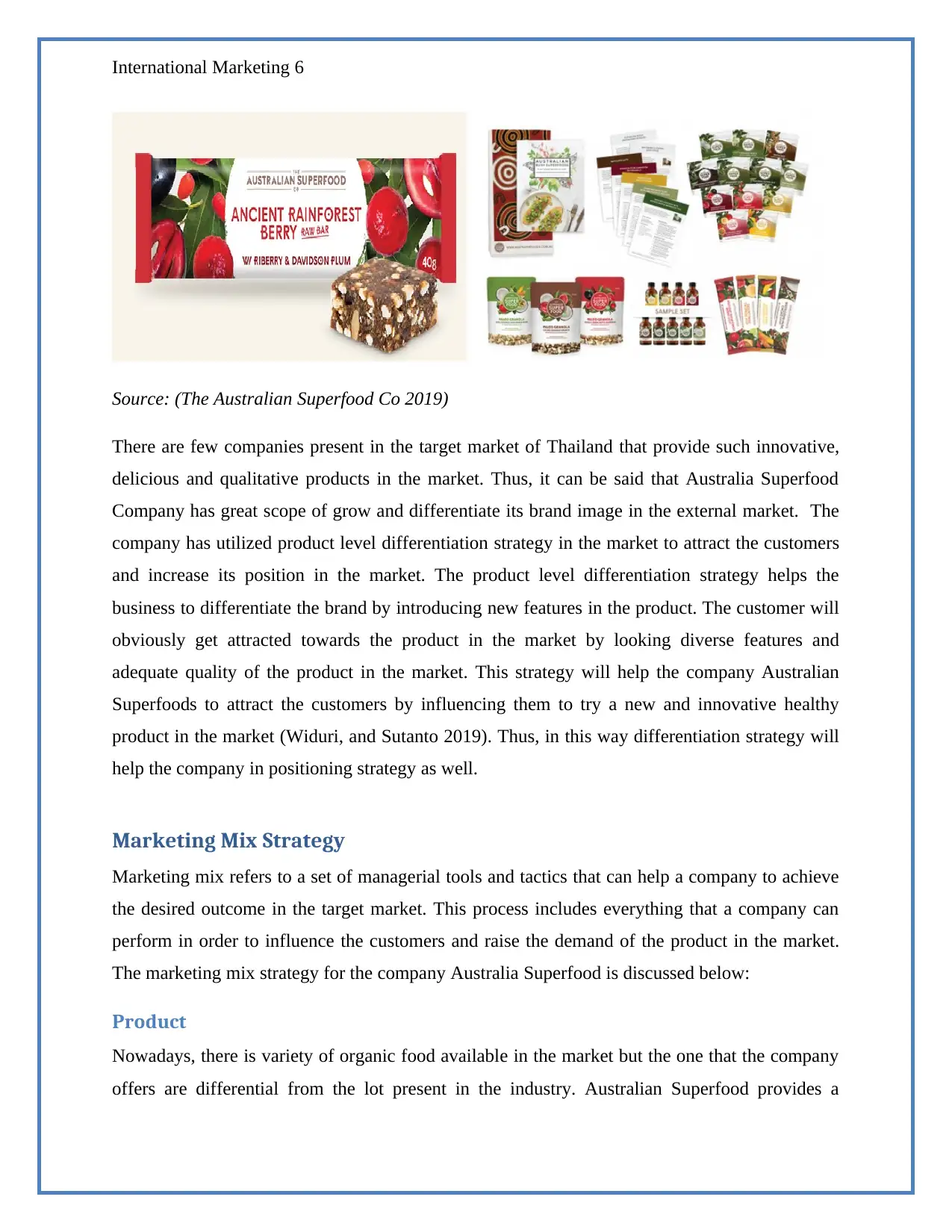
International Marketing 6
Source: (The Australian Superfood Co 2019)
There are few companies present in the target market of Thailand that provide such innovative,
delicious and qualitative products in the market. Thus, it can be said that Australia Superfood
Company has great scope of grow and differentiate its brand image in the external market. The
company has utilized product level differentiation strategy in the market to attract the customers
and increase its position in the market. The product level differentiation strategy helps the
business to differentiate the brand by introducing new features in the product. The customer will
obviously get attracted towards the product in the market by looking diverse features and
adequate quality of the product in the market. This strategy will help the company Australian
Superfoods to attract the customers by influencing them to try a new and innovative healthy
product in the market (Widuri, and Sutanto 2019). Thus, in this way differentiation strategy will
help the company in positioning strategy as well.
Marketing Mix Strategy
Marketing mix refers to a set of managerial tools and tactics that can help a company to achieve
the desired outcome in the target market. This process includes everything that a company can
perform in order to influence the customers and raise the demand of the product in the market.
The marketing mix strategy for the company Australia Superfood is discussed below:
Product
Nowadays, there is variety of organic food available in the market but the one that the company
offers are differential from the lot present in the industry. Australian Superfood provides a
Source: (The Australian Superfood Co 2019)
There are few companies present in the target market of Thailand that provide such innovative,
delicious and qualitative products in the market. Thus, it can be said that Australia Superfood
Company has great scope of grow and differentiate its brand image in the external market. The
company has utilized product level differentiation strategy in the market to attract the customers
and increase its position in the market. The product level differentiation strategy helps the
business to differentiate the brand by introducing new features in the product. The customer will
obviously get attracted towards the product in the market by looking diverse features and
adequate quality of the product in the market. This strategy will help the company Australian
Superfoods to attract the customers by influencing them to try a new and innovative healthy
product in the market (Widuri, and Sutanto 2019). Thus, in this way differentiation strategy will
help the company in positioning strategy as well.
Marketing Mix Strategy
Marketing mix refers to a set of managerial tools and tactics that can help a company to achieve
the desired outcome in the target market. This process includes everything that a company can
perform in order to influence the customers and raise the demand of the product in the market.
The marketing mix strategy for the company Australia Superfood is discussed below:
Product
Nowadays, there is variety of organic food available in the market but the one that the company
offers are differential from the lot present in the industry. Australian Superfood provides a
Paraphrase This Document
Need a fresh take? Get an instant paraphrase of this document with our AI Paraphraser
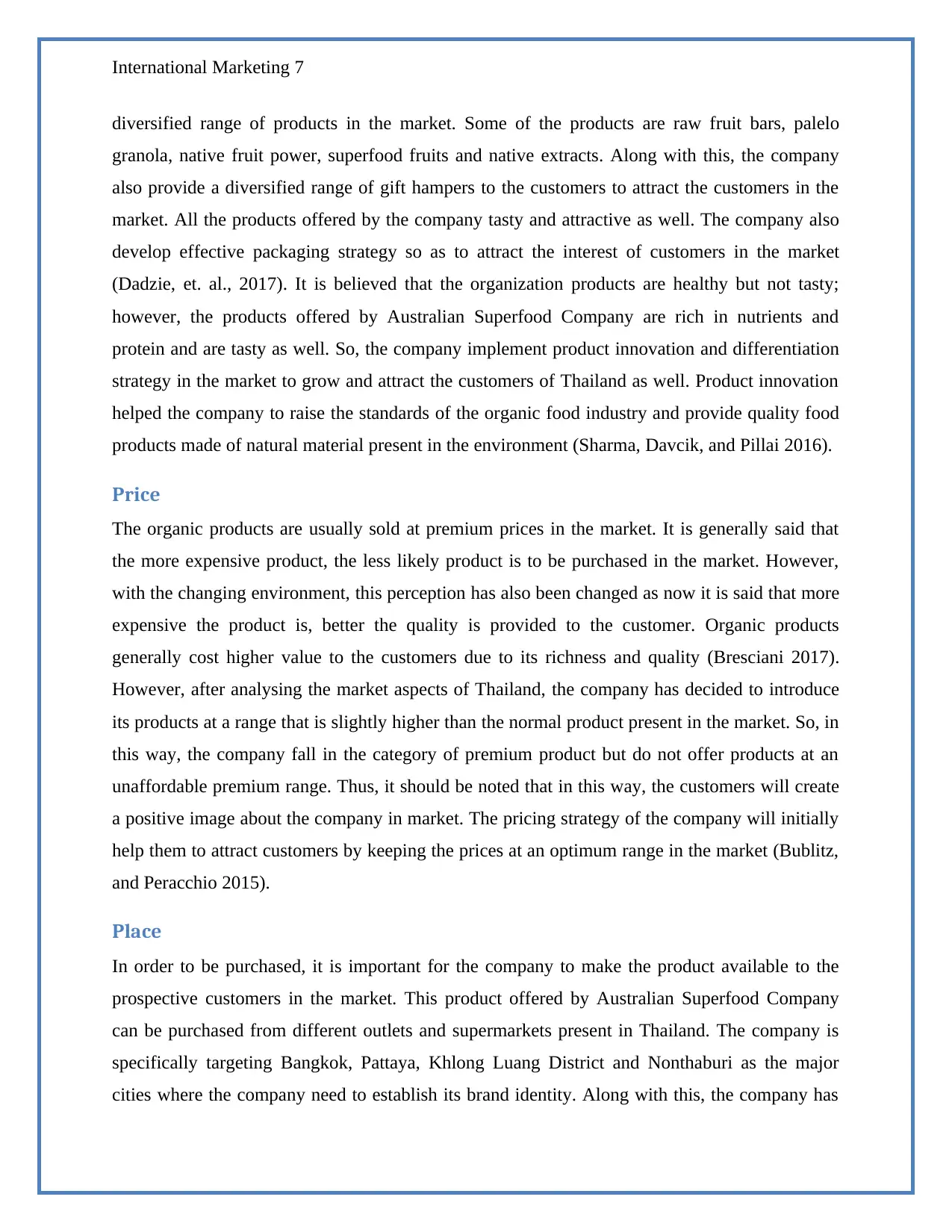
International Marketing 7
diversified range of products in the market. Some of the products are raw fruit bars, palelo
granola, native fruit power, superfood fruits and native extracts. Along with this, the company
also provide a diversified range of gift hampers to the customers to attract the customers in the
market. All the products offered by the company tasty and attractive as well. The company also
develop effective packaging strategy so as to attract the interest of customers in the market
(Dadzie, et. al., 2017). It is believed that the organization products are healthy but not tasty;
however, the products offered by Australian Superfood Company are rich in nutrients and
protein and are tasty as well. So, the company implement product innovation and differentiation
strategy in the market to grow and attract the customers of Thailand as well. Product innovation
helped the company to raise the standards of the organic food industry and provide quality food
products made of natural material present in the environment (Sharma, Davcik, and Pillai 2016).
Price
The organic products are usually sold at premium prices in the market. It is generally said that
the more expensive product, the less likely product is to be purchased in the market. However,
with the changing environment, this perception has also been changed as now it is said that more
expensive the product is, better the quality is provided to the customer. Organic products
generally cost higher value to the customers due to its richness and quality (Bresciani 2017).
However, after analysing the market aspects of Thailand, the company has decided to introduce
its products at a range that is slightly higher than the normal product present in the market. So, in
this way, the company fall in the category of premium product but do not offer products at an
unaffordable premium range. Thus, it should be noted that in this way, the customers will create
a positive image about the company in market. The pricing strategy of the company will initially
help them to attract customers by keeping the prices at an optimum range in the market (Bublitz,
and Peracchio 2015).
Place
In order to be purchased, it is important for the company to make the product available to the
prospective customers in the market. This product offered by Australian Superfood Company
can be purchased from different outlets and supermarkets present in Thailand. The company is
specifically targeting Bangkok, Pattaya, Khlong Luang District and Nonthaburi as the major
cities where the company need to establish its brand identity. Along with this, the company has
diversified range of products in the market. Some of the products are raw fruit bars, palelo
granola, native fruit power, superfood fruits and native extracts. Along with this, the company
also provide a diversified range of gift hampers to the customers to attract the customers in the
market. All the products offered by the company tasty and attractive as well. The company also
develop effective packaging strategy so as to attract the interest of customers in the market
(Dadzie, et. al., 2017). It is believed that the organization products are healthy but not tasty;
however, the products offered by Australian Superfood Company are rich in nutrients and
protein and are tasty as well. So, the company implement product innovation and differentiation
strategy in the market to grow and attract the customers of Thailand as well. Product innovation
helped the company to raise the standards of the organic food industry and provide quality food
products made of natural material present in the environment (Sharma, Davcik, and Pillai 2016).
Price
The organic products are usually sold at premium prices in the market. It is generally said that
the more expensive product, the less likely product is to be purchased in the market. However,
with the changing environment, this perception has also been changed as now it is said that more
expensive the product is, better the quality is provided to the customer. Organic products
generally cost higher value to the customers due to its richness and quality (Bresciani 2017).
However, after analysing the market aspects of Thailand, the company has decided to introduce
its products at a range that is slightly higher than the normal product present in the market. So, in
this way, the company fall in the category of premium product but do not offer products at an
unaffordable premium range. Thus, it should be noted that in this way, the customers will create
a positive image about the company in market. The pricing strategy of the company will initially
help them to attract customers by keeping the prices at an optimum range in the market (Bublitz,
and Peracchio 2015).
Place
In order to be purchased, it is important for the company to make the product available to the
prospective customers in the market. This product offered by Australian Superfood Company
can be purchased from different outlets and supermarkets present in Thailand. The company is
specifically targeting Bangkok, Pattaya, Khlong Luang District and Nonthaburi as the major
cities where the company need to establish its brand identity. Along with this, the company has
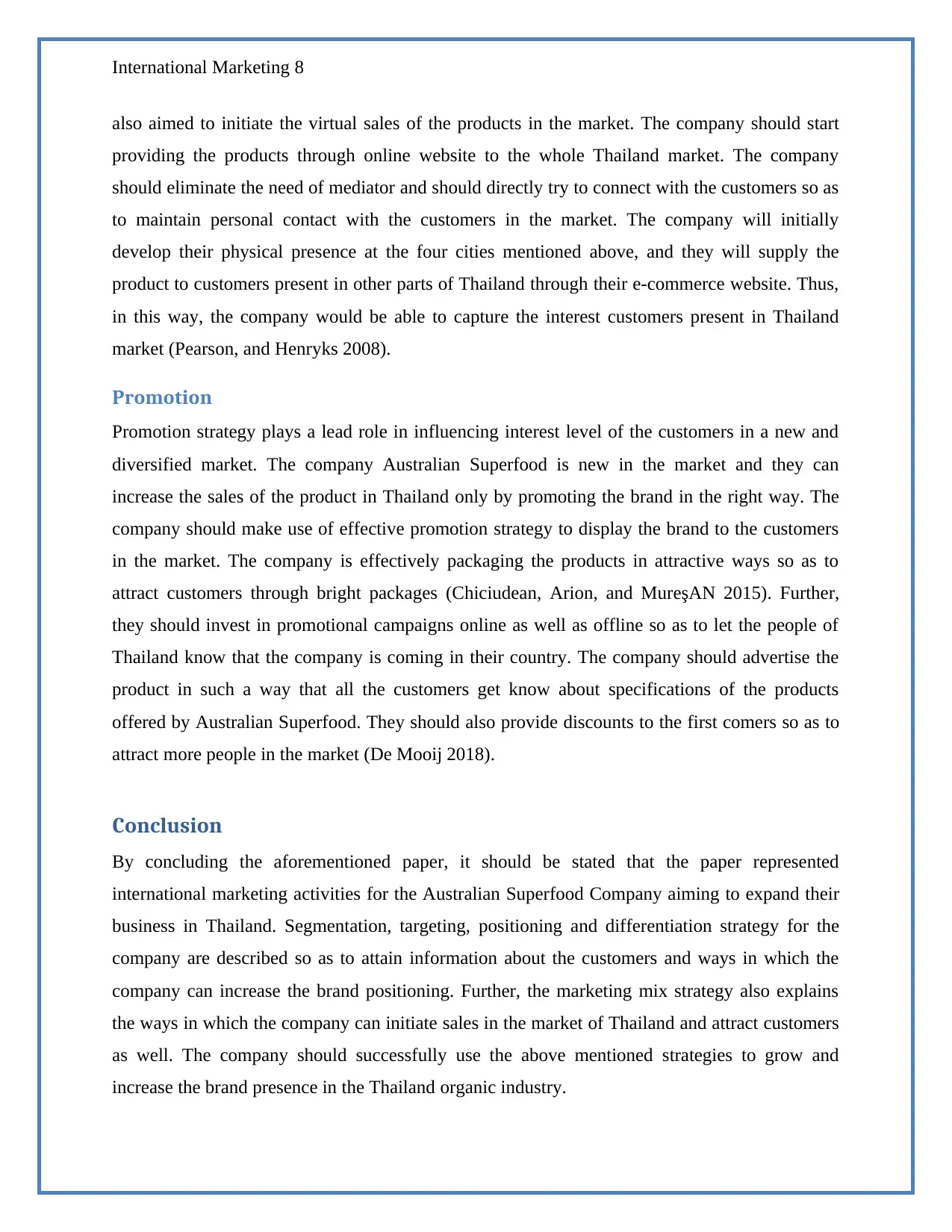
International Marketing 8
also aimed to initiate the virtual sales of the products in the market. The company should start
providing the products through online website to the whole Thailand market. The company
should eliminate the need of mediator and should directly try to connect with the customers so as
to maintain personal contact with the customers in the market. The company will initially
develop their physical presence at the four cities mentioned above, and they will supply the
product to customers present in other parts of Thailand through their e-commerce website. Thus,
in this way, the company would be able to capture the interest customers present in Thailand
market (Pearson, and Henryks 2008).
Promotion
Promotion strategy plays a lead role in influencing interest level of the customers in a new and
diversified market. The company Australian Superfood is new in the market and they can
increase the sales of the product in Thailand only by promoting the brand in the right way. The
company should make use of effective promotion strategy to display the brand to the customers
in the market. The company is effectively packaging the products in attractive ways so as to
attract customers through bright packages (Chiciudean, Arion, and MureşAN 2015). Further,
they should invest in promotional campaigns online as well as offline so as to let the people of
Thailand know that the company is coming in their country. The company should advertise the
product in such a way that all the customers get know about specifications of the products
offered by Australian Superfood. They should also provide discounts to the first comers so as to
attract more people in the market (De Mooij 2018).
Conclusion
By concluding the aforementioned paper, it should be stated that the paper represented
international marketing activities for the Australian Superfood Company aiming to expand their
business in Thailand. Segmentation, targeting, positioning and differentiation strategy for the
company are described so as to attain information about the customers and ways in which the
company can increase the brand positioning. Further, the marketing mix strategy also explains
the ways in which the company can initiate sales in the market of Thailand and attract customers
as well. The company should successfully use the above mentioned strategies to grow and
increase the brand presence in the Thailand organic industry.
also aimed to initiate the virtual sales of the products in the market. The company should start
providing the products through online website to the whole Thailand market. The company
should eliminate the need of mediator and should directly try to connect with the customers so as
to maintain personal contact with the customers in the market. The company will initially
develop their physical presence at the four cities mentioned above, and they will supply the
product to customers present in other parts of Thailand through their e-commerce website. Thus,
in this way, the company would be able to capture the interest customers present in Thailand
market (Pearson, and Henryks 2008).
Promotion
Promotion strategy plays a lead role in influencing interest level of the customers in a new and
diversified market. The company Australian Superfood is new in the market and they can
increase the sales of the product in Thailand only by promoting the brand in the right way. The
company should make use of effective promotion strategy to display the brand to the customers
in the market. The company is effectively packaging the products in attractive ways so as to
attract customers through bright packages (Chiciudean, Arion, and MureşAN 2015). Further,
they should invest in promotional campaigns online as well as offline so as to let the people of
Thailand know that the company is coming in their country. The company should advertise the
product in such a way that all the customers get know about specifications of the products
offered by Australian Superfood. They should also provide discounts to the first comers so as to
attract more people in the market (De Mooij 2018).
Conclusion
By concluding the aforementioned paper, it should be stated that the paper represented
international marketing activities for the Australian Superfood Company aiming to expand their
business in Thailand. Segmentation, targeting, positioning and differentiation strategy for the
company are described so as to attain information about the customers and ways in which the
company can increase the brand positioning. Further, the marketing mix strategy also explains
the ways in which the company can initiate sales in the market of Thailand and attract customers
as well. The company should successfully use the above mentioned strategies to grow and
increase the brand presence in the Thailand organic industry.
⊘ This is a preview!⊘
Do you want full access?
Subscribe today to unlock all pages.

Trusted by 1+ million students worldwide

International Marketing 9
Paraphrase This Document
Need a fresh take? Get an instant paraphrase of this document with our AI Paraphraser
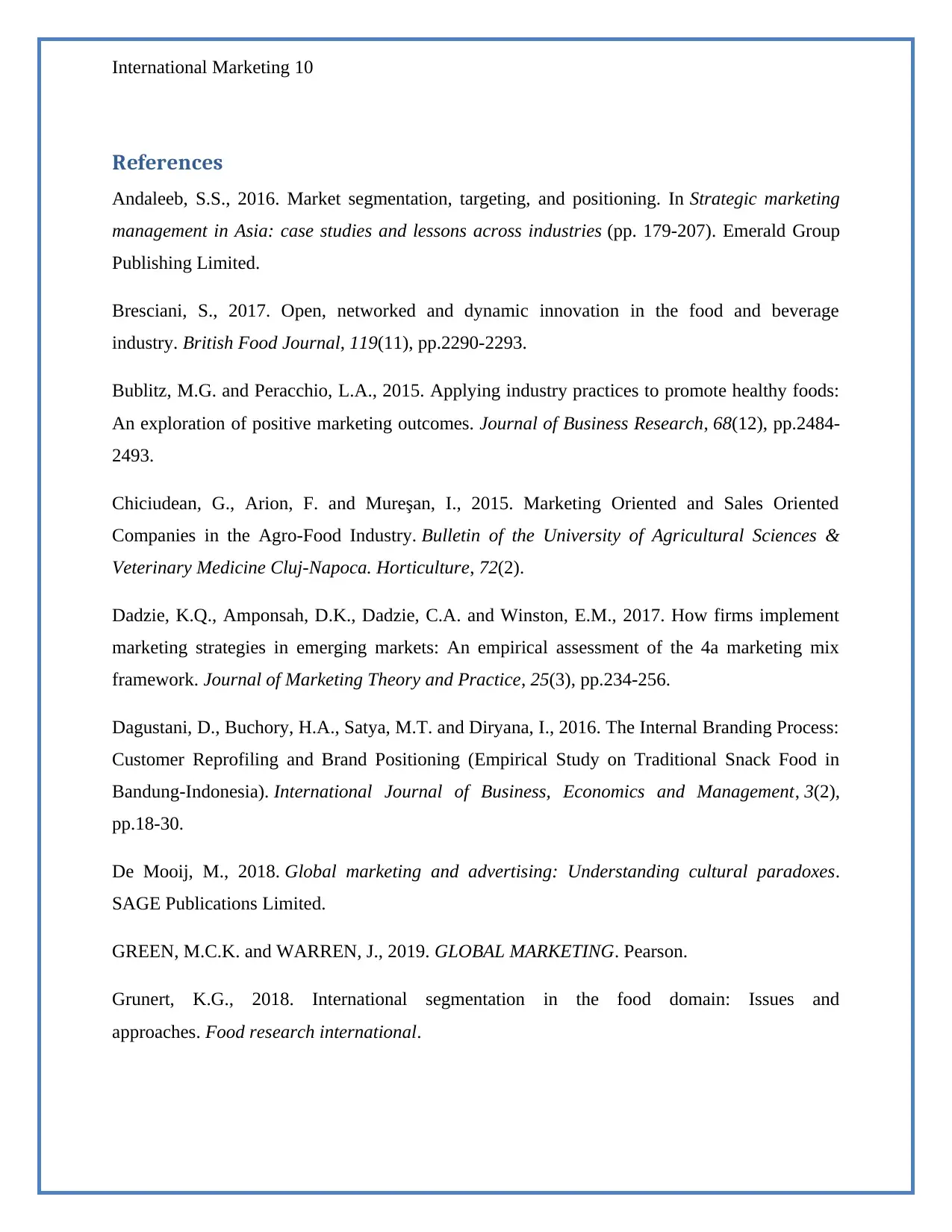
International Marketing 10
References
Andaleeb, S.S., 2016. Market segmentation, targeting, and positioning. In Strategic marketing
management in Asia: case studies and lessons across industries (pp. 179-207). Emerald Group
Publishing Limited.
Bresciani, S., 2017. Open, networked and dynamic innovation in the food and beverage
industry. British Food Journal, 119(11), pp.2290-2293.
Bublitz, M.G. and Peracchio, L.A., 2015. Applying industry practices to promote healthy foods:
An exploration of positive marketing outcomes. Journal of Business Research, 68(12), pp.2484-
2493.
Chiciudean, G., Arion, F. and Mureşan, I., 2015. Marketing Oriented and Sales Oriented
Companies in the Agro-Food Industry. Bulletin of the University of Agricultural Sciences &
Veterinary Medicine Cluj-Napoca. Horticulture, 72(2).
Dadzie, K.Q., Amponsah, D.K., Dadzie, C.A. and Winston, E.M., 2017. How firms implement
marketing strategies in emerging markets: An empirical assessment of the 4a marketing mix
framework. Journal of Marketing Theory and Practice, 25(3), pp.234-256.
Dagustani, D., Buchory, H.A., Satya, M.T. and Diryana, I., 2016. The Internal Branding Process:
Customer Reprofiling and Brand Positioning (Empirical Study on Traditional Snack Food in
Bandung-Indonesia). International Journal of Business, Economics and Management, 3(2),
pp.18-30.
De Mooij, M., 2018. Global marketing and advertising: Understanding cultural paradoxes.
SAGE Publications Limited.
GREEN, M.C.K. and WARREN, J., 2019. GLOBAL MARKETING. Pearson.
Grunert, K.G., 2018. International segmentation in the food domain: Issues and
approaches. Food research international.
References
Andaleeb, S.S., 2016. Market segmentation, targeting, and positioning. In Strategic marketing
management in Asia: case studies and lessons across industries (pp. 179-207). Emerald Group
Publishing Limited.
Bresciani, S., 2017. Open, networked and dynamic innovation in the food and beverage
industry. British Food Journal, 119(11), pp.2290-2293.
Bublitz, M.G. and Peracchio, L.A., 2015. Applying industry practices to promote healthy foods:
An exploration of positive marketing outcomes. Journal of Business Research, 68(12), pp.2484-
2493.
Chiciudean, G., Arion, F. and Mureşan, I., 2015. Marketing Oriented and Sales Oriented
Companies in the Agro-Food Industry. Bulletin of the University of Agricultural Sciences &
Veterinary Medicine Cluj-Napoca. Horticulture, 72(2).
Dadzie, K.Q., Amponsah, D.K., Dadzie, C.A. and Winston, E.M., 2017. How firms implement
marketing strategies in emerging markets: An empirical assessment of the 4a marketing mix
framework. Journal of Marketing Theory and Practice, 25(3), pp.234-256.
Dagustani, D., Buchory, H.A., Satya, M.T. and Diryana, I., 2016. The Internal Branding Process:
Customer Reprofiling and Brand Positioning (Empirical Study on Traditional Snack Food in
Bandung-Indonesia). International Journal of Business, Economics and Management, 3(2),
pp.18-30.
De Mooij, M., 2018. Global marketing and advertising: Understanding cultural paradoxes.
SAGE Publications Limited.
GREEN, M.C.K. and WARREN, J., 2019. GLOBAL MARKETING. Pearson.
Grunert, K.G., 2018. International segmentation in the food domain: Issues and
approaches. Food research international.
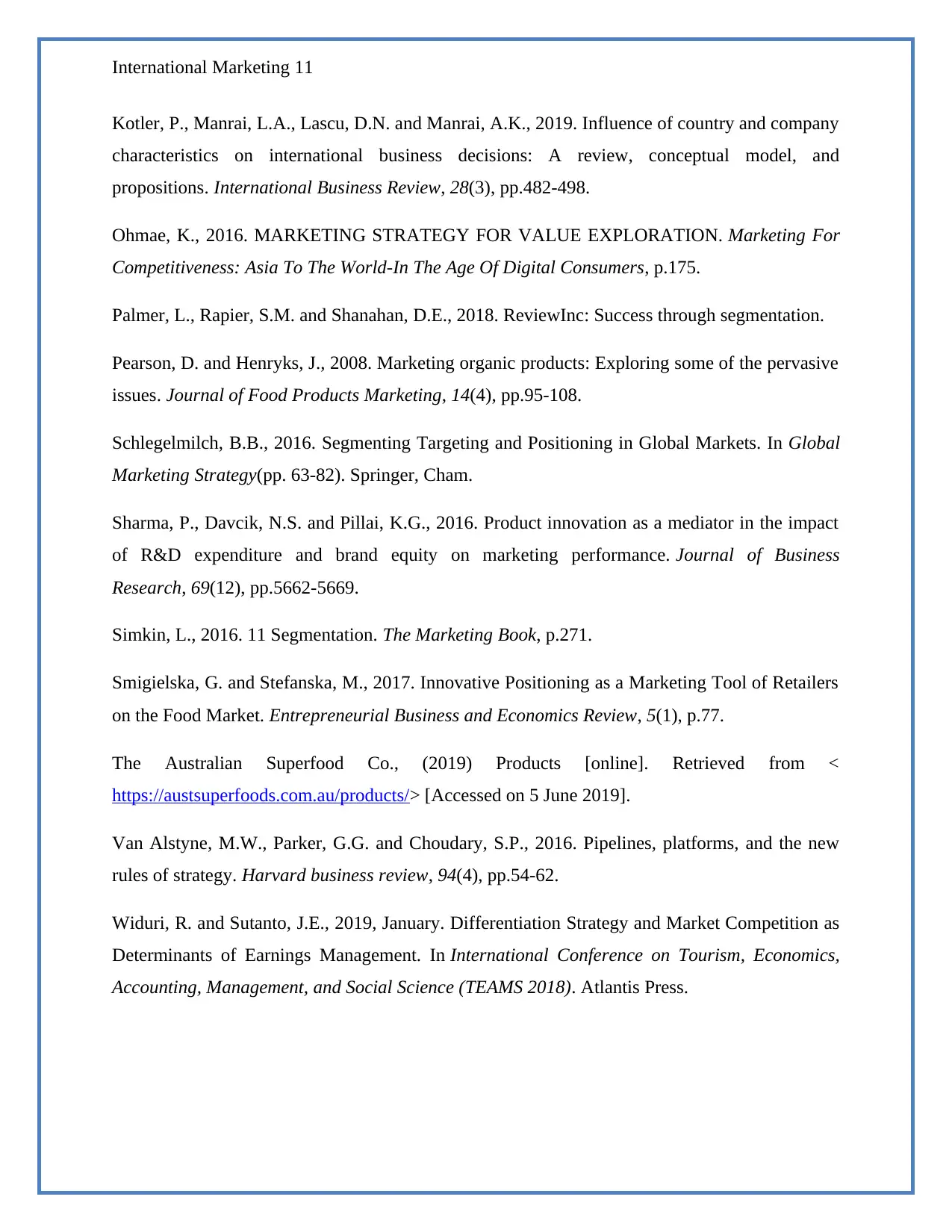
International Marketing 11
Kotler, P., Manrai, L.A., Lascu, D.N. and Manrai, A.K., 2019. Influence of country and company
characteristics on international business decisions: A review, conceptual model, and
propositions. International Business Review, 28(3), pp.482-498.
Ohmae, K., 2016. MARKETING STRATEGY FOR VALUE EXPLORATION. Marketing For
Competitiveness: Asia To The World-In The Age Of Digital Consumers, p.175.
Palmer, L., Rapier, S.M. and Shanahan, D.E., 2018. ReviewInc: Success through segmentation.
Pearson, D. and Henryks, J., 2008. Marketing organic products: Exploring some of the pervasive
issues. Journal of Food Products Marketing, 14(4), pp.95-108.
Schlegelmilch, B.B., 2016. Segmenting Targeting and Positioning in Global Markets. In Global
Marketing Strategy(pp. 63-82). Springer, Cham.
Sharma, P., Davcik, N.S. and Pillai, K.G., 2016. Product innovation as a mediator in the impact
of R&D expenditure and brand equity on marketing performance. Journal of Business
Research, 69(12), pp.5662-5669.
Simkin, L., 2016. 11 Segmentation. The Marketing Book, p.271.
Smigielska, G. and Stefanska, M., 2017. Innovative Positioning as a Marketing Tool of Retailers
on the Food Market. Entrepreneurial Business and Economics Review, 5(1), p.77.
The Australian Superfood Co., (2019) Products [online]. Retrieved from <
https://austsuperfoods.com.au/products/> [Accessed on 5 June 2019].
Van Alstyne, M.W., Parker, G.G. and Choudary, S.P., 2016. Pipelines, platforms, and the new
rules of strategy. Harvard business review, 94(4), pp.54-62.
Widuri, R. and Sutanto, J.E., 2019, January. Differentiation Strategy and Market Competition as
Determinants of Earnings Management. In International Conference on Tourism, Economics,
Accounting, Management, and Social Science (TEAMS 2018). Atlantis Press.
Kotler, P., Manrai, L.A., Lascu, D.N. and Manrai, A.K., 2019. Influence of country and company
characteristics on international business decisions: A review, conceptual model, and
propositions. International Business Review, 28(3), pp.482-498.
Ohmae, K., 2016. MARKETING STRATEGY FOR VALUE EXPLORATION. Marketing For
Competitiveness: Asia To The World-In The Age Of Digital Consumers, p.175.
Palmer, L., Rapier, S.M. and Shanahan, D.E., 2018. ReviewInc: Success through segmentation.
Pearson, D. and Henryks, J., 2008. Marketing organic products: Exploring some of the pervasive
issues. Journal of Food Products Marketing, 14(4), pp.95-108.
Schlegelmilch, B.B., 2016. Segmenting Targeting and Positioning in Global Markets. In Global
Marketing Strategy(pp. 63-82). Springer, Cham.
Sharma, P., Davcik, N.S. and Pillai, K.G., 2016. Product innovation as a mediator in the impact
of R&D expenditure and brand equity on marketing performance. Journal of Business
Research, 69(12), pp.5662-5669.
Simkin, L., 2016. 11 Segmentation. The Marketing Book, p.271.
Smigielska, G. and Stefanska, M., 2017. Innovative Positioning as a Marketing Tool of Retailers
on the Food Market. Entrepreneurial Business and Economics Review, 5(1), p.77.
The Australian Superfood Co., (2019) Products [online]. Retrieved from <
https://austsuperfoods.com.au/products/> [Accessed on 5 June 2019].
Van Alstyne, M.W., Parker, G.G. and Choudary, S.P., 2016. Pipelines, platforms, and the new
rules of strategy. Harvard business review, 94(4), pp.54-62.
Widuri, R. and Sutanto, J.E., 2019, January. Differentiation Strategy and Market Competition as
Determinants of Earnings Management. In International Conference on Tourism, Economics,
Accounting, Management, and Social Science (TEAMS 2018). Atlantis Press.
⊘ This is a preview!⊘
Do you want full access?
Subscribe today to unlock all pages.

Trusted by 1+ million students worldwide
1 out of 12
Related Documents
Your All-in-One AI-Powered Toolkit for Academic Success.
+13062052269
info@desklib.com
Available 24*7 on WhatsApp / Email
![[object Object]](/_next/static/media/star-bottom.7253800d.svg)
Unlock your academic potential
Copyright © 2020–2025 A2Z Services. All Rights Reserved. Developed and managed by ZUCOL.



